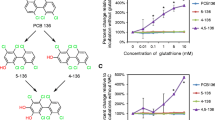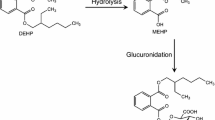Abstract
Tissue distribution and effects induced by 2,2′,4,4′,5,5′-hexachlorobiphenyl (245-HCB) on cytochrome P450 isozymes were compared with those of 2,2′,3,3′,6,6′-hexachlorobiphenyl (236-HCB). Male Wistar rats were given a single intragastric dose (23 mg/kg body wt) of either isomer, and killed after 72 h. At termination the tissue concentrations of 245-HCB were considerably higher than those of 236-HCB, suggesting a more effective metabolism of the latter. The binding affinity of 236-HCB to cytochrome P450 was higher and the magnitude of binding greater than of 245-HCB. 245-HCB-treatment elevated the hepatic concentration of cytochrome P450 and also the activities of 7-pentoxyresorufin O-depentylase (50-fold), aniline p-hydroxylase (2-fold) and 7-ethoxycoumarin O-deethylase (2-fold), a response typical of phenobarbital-type inducers. In the Western immunoblot of liver microsomes from 245-HCB treated rats, an increased amount of P450IIB1/2 was detected by a monoclonal antibody 2-66-3, which specifically detects phenobarbital inducible isoenzymes. The minimum molecular mass of the P450 isozyme induced was 52 kDa. After 236-HCB administration, a weak inducing effect was observed.
Similar content being viewed by others
Abbreviations
- 245-HCB:
-
2,2′,4,4′,5,5′-hexachlorobiphenyl
- 236-HCB:
-
2,2′,3,3′,6,6′-hexachlorobiphenyl
- Mab:
-
monoclonal antibody
References
Aitio A (1978) A simple, and sensitive assay of 7-ethoxycoumarin deethylation. Anal Biochem 85: 488–491
Bandiera S, Safe S, Okey AB (1982) Binding of polychlorinated biphenyls classified as either phenobarbitone-, 3-methylcholanthrene-, or mixed-type inducers to cytosolic Ah receptor. Chem Biol Interact 39: 259–277
Brandt I, Bergman Å (1981) Bronchial mucosal and kidney cortex affinity of 4- and 4,4′-substituted sulphur-containing derivatives of 2,2′-5,5′-tetrachlorobiphenyls in mice. Chem Biol Interact 34: 47–55
Brandt I, Mohammed A, Slanina P (1981) Persistence of 2,3,6-substituted pentachlorobiphenyls in the lung parenchyma: a new structure-dependent tissue localization of polychlorinated biphenyls in mice. Toxicology 21: 317–322
Burke MD, Thompson S, Elcombe CR, Halbert J, Haaparanta T, Mayer RT (1985) Ethoxy-, pentoxy- and benzyloxphenoxazones and homologues: a series of substrates to distuiguish between different induced cytochromes P-450. Biochem Pharmacol 34: 3337–3345
Elovaara E, Zitting A, Nickels J, Aitio A (1987) m-Xylene inhalation destroys cytochrome P450 in rat lung at low exposure. Arch Toxicol 61: 21–26
Gelboin HV, Friedman FK (1985) Monoclonal antibodies for studies on xenobiotic and endobiotic metabolism. Cytochromes P-450 as a paradigm. Biochem Pharmacol 34: 2225–2234
Giuliano KA, Lau EP, Fall RR (1980) Simplified liquid Chromatographic assay for epoxide hydrolase. J Chromatogr 202: 447–452
Hänninen O (1968) On the metabolic regulation in the glucuronic acid pathway in the rat tissue. Ann Acad Sci Fenn Ser AII 142: 1–96
Kato S, McKinney JD, Matthews HB (1980) Metabolism of symmetrical hexachlorobiphenyl isomers in the rat. Toxicol Appl Pharmacol 53: 389–398
Kelley M, Hantelle P, Safe S, Levin W, Thomas PE (1987) Co-induction of cytochrome P-450 isozyms in rat liver by 2,4,5,2′,4′,5′-hexachlorobiphenyl of 3-methoxy-4-aminoazobenzene. Mol Pharmacol 32: 206–211
Ko IY, Park SS, Song BJ, Patten C, Tan Y, Hah Y, Yang CS, Gelboin HV (1987) Monoclonal antibodies to ethanol-induced rat liver cytochrome P-450 that metabolizes aniline and nitrosoamines. Cancer Res 47: 3101–3109
Lowry OH, Rosenbrough HJ, Farr AL, Randall RJ (1951) Protein measurement with Folin phenol reagent. J Biol Chem 193: 265–275
Luotamo M, Järvisalo J, Aitio A (1985) Analysis of polychlorinated biphenyls (PCB) in human serum. Environ Health Perspect 60: 327–332
Lutz RJ, Dedrick RL, Tuey DD, Sipes IG, Anderson MW, Matthews HB (1984) Comparison of the pharmacokinetics of several polychlorinated biphenyls in mouse, rat, dog and monkey by means of a physiological pharmacokinetic model. Drug Metab Dispos 12: 527–535
Matthews HB, Dedrick RL (1984) Pharmacokinetics of PCBs. Annu Rev Pharmacol Toxicol 24: 85–103
Matthews HB, Tueye DB (1980) The effect of chlorine position on the distribution and excretion of four hexachlorobiphenyl isomers. Toxicol Appl Pharmacol 53: 377–388
Mühlebach S, Bickel MH (1981) Pharmacokinetics in rats of 2,4,5,2′,4′,5′-hexachlorobiphenyl, an unmetabolized lipophilic model compound. Xenobiotica 11 [4]: 249–257
Mühlebach S, Wyss PA, Bickel MH (1985) Comparative adipose tissue kinetics of thiopental, DDE and 2,4,5,2′,4′,5′-hexachlorobiphenyl in the rat. Xenobiotica 15 [6]: 485–491
Nakajima T, Elovaara E, Park SS, Gelboin HV, Hietanen E, Vainio H (1991) Monoclonal antibody-directed characterization of benzene, ethoxyresorufin and pentoxyresorufin metabolism in rat liver microsomes. Biochem Pharmacol (in press)
Nebert DW, Nelson DR, Adesnik M, Coon M, Estabrool RW, Gonzales FJ, Guengerich FP, Gunsalus IC, Johnson EF, Kemper B, Levin W, Phillips IR, Sato R, Waterman R (1989) The P450 superfamily: updated listing of all genes and recommended nomenclature for the chromosomal loci. DNA 8 [1]: 1–13
O'Brien PJ, Rahimtula AD (1978) Peroxidase assay for cytochrome P450: assay of aniline hyroxylase. Methods Enzymol LII [Part C]: 407–412
Omura T, Sato R (1964) The carbon monoxide binding pigment of liver microsomes. I. Evidence for its hemoprotein nature. J Biol Chem 139: 2370–2378
Park SS, Fujino T, Miller H, Guengerich FP, Gelboin HV (1984) Monoclonal antibodies to phenobarbital-induced rat liver cytochrome P-450. Biochem Pharmacol 33: 2071–2081
Parkinson A, Robertson LW, Safe L, Safe S (1981) Polychlorinated biphenyls as inducers of hepatic microsomal enzymes: effects of diortho substitution. Chem Biol Interact 35: 1–12
Parkki MG, Marniemi J, Vainio H (1977) Long-term effects of single combined doses of DDT and PCB on drug-metabolizing enzymes in rat liver. J Toxicol Environ Health 3: 903–911
Raunio H, Kojo A, Juvonen R, Honkakoski P, Järvinen P, Lang M, Vähäkangas K, Gelboin H, Park SS, Pelkonen O (1988) Mouse hepatic cytochrome P-450 isozyme induction by 1,4-bis[2-(3,5-dichloropyridyloxy)]benzene, pyrazole, and phenobarbital. Biochem Pharmacol 37: 4141–4147
Safe S (1984) Polychlorinated biphenyls (PCBs) and polybrominated biphenyls (PBBs): biochemistry, toxicology and mechanism of action. CRC Crit Rev Toxicol 13: 319–395
Schnellmann RG, Putnam CW, Sipes G (1983) Metabolism of 2,2′,3,3′,6,6′-hexachlorobiphenyl and 2,2′,4,4′,5,5′-hexachloro-biphenyl by human hepatic microsomes. Biochem Pharmacol 32: 3233–3239
Sipes IG, Slogumb ML, Chen H-SG, Carter DE (1982) 2,3,6,2′,3′,6′-Hexachlorobiphenyl: distribution, metabolism and excretion in the dog and the monkey. Toxicol Appl Pharmacol 62: 317–324
Sundström G, Hutzinger O, Safe S (1976) The metabolism of chlorobiphenyls — a review. Chemosphere 5: 267–298
Vainio H (1974) Enhancement of microsomal drug oxidation and glucuronidation in rat liver by an environmental chemical, polychlorinated biphenyl. Chem Biol Interact 9: 379–387
Wyss PA, Mühlebach S, Bickel MH (1982) Pharmacokinetics of 2,2′,4,4′,5,5′-hexachlorobiphenyl (6-CB) in rats with decreasing adipose tissue mass. Drug Metab Dispos 10: 657–661
Author information
Authors and Affiliations
Rights and permissions
About this article
Cite this article
Luotamo, M., Elovaara, E., Raunio, H. et al. Distribution and effects on cytochrome P450 system of two hexachlorobiphenyl isomers in the rat. Arch Toxicol 65, 661–665 (1991). https://doi.org/10.1007/BF02098033
Issue Date:
DOI: https://doi.org/10.1007/BF02098033




